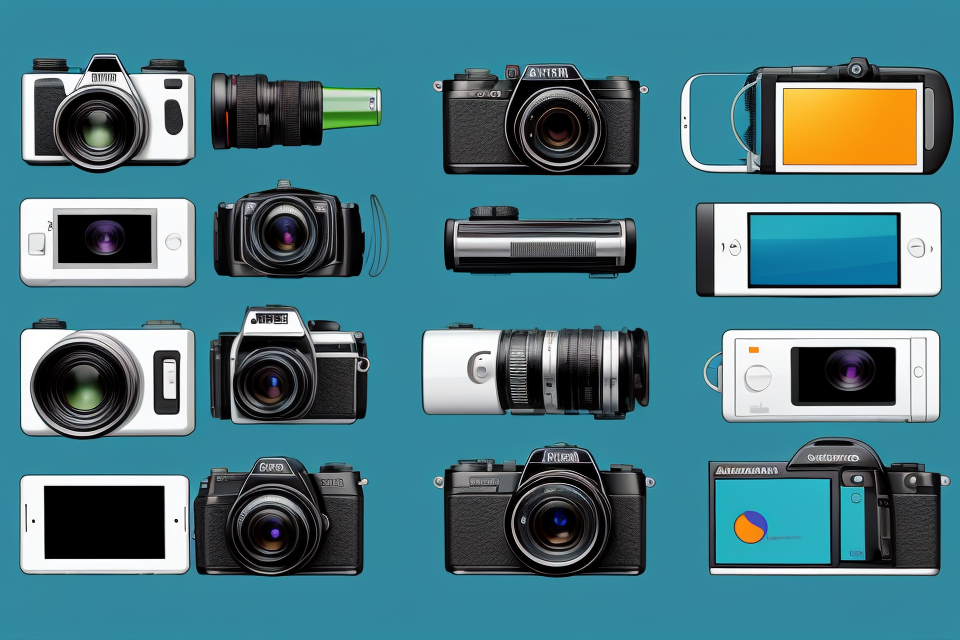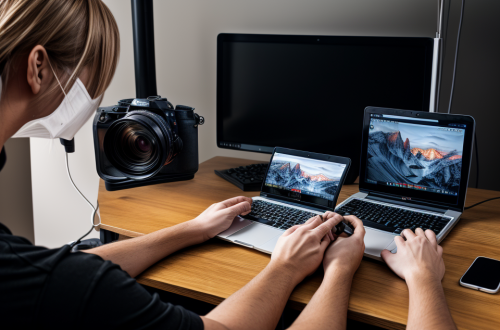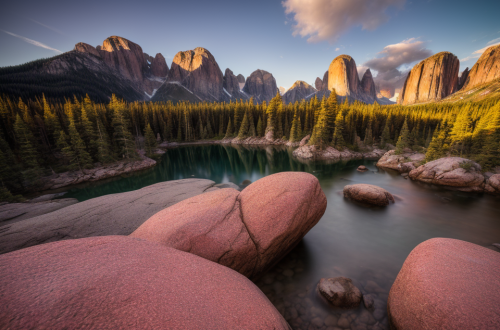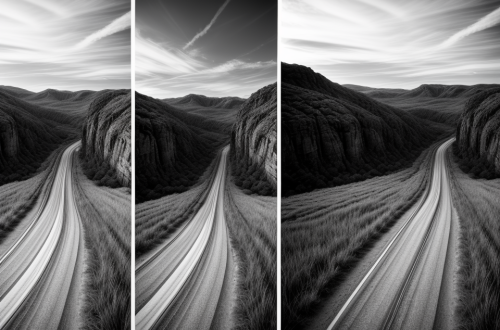Are you wondering what the difference is between digital photography and regular photography? In this article, we will explore the key differences between the two and help you understand why digital photography has become the go-to choice for many photographers. We will discuss the advantages of digital photography, such as the ability to edit and store images easily, and how it has revolutionized the photography industry. So, whether you’re a seasoned photographer or just starting out, read on to discover the differences between digital and regular photography and why digital is the way of the future.
The Basics of Digital and Regular Photography
How Digital Photography Works
Digital photography has revolutionized the way we capture and process images. It works by using digital cameras that convert light into digital information through an image sensor. This digital information is then processed by the camera’s electronic circuitry and stored on a digital storage medium, such as a memory card or hard drive.
Digital cameras use an image sensor to capture light and convert it into digital information. The image sensor is a device that contains an array of pixels, which are tiny sensors that detect light. When light enters the camera, it hits the image sensor, which then converts the light into an electrical signal. This electrical signal is then processed by the camera’s electronic circuitry.
The role of the image sensor is crucial in digital photography as it determines the quality of the image. The more pixels an image sensor has, the higher the resolution of the image will be. The image sensor is also responsible for capturing the color and brightness of the image.
In addition to the image sensor, digital cameras also use a storage medium to store the digital information. This can be a memory card or a hard drive. The storage medium is where the digital information is saved and can be retrieved later for viewing or editing.
Overall, digital photography works by using an image sensor to capture light and convert it into digital information, which is then processed by the camera’s electronic circuitry and stored on a digital storage medium. The quality of the image is determined by the resolution and capabilities of the image sensor, and the storage capacity of the storage medium.
How Regular Photography Works
Regular photography, also known as film photography, is a process that has been around for over a century. It involves the use of film to capture and record images. In this section, we will delve into the intricacies of how regular photography works.
Explanation of Film Photography
Film photography is a process that uses light-sensitive film to capture and record images. The film is coated with a light-sensitive emulsion that reacts to light and forms an image. The film is placed into a camera, where it is exposed to light for a specific amount of time, depending on the desired exposure.
How Light is Captured on Film
When light enters the camera, it passes through the lens and hits the film. The film is made up of a series of light-sensitive crystals that react to light and form an image. The crystals are arranged in a grid pattern on the film, and each crystal corresponds to a pixel in the final image.
The amount of light that hits each crystal determines how much it will darken, and this determines the final intensity of the image. The more light that hits a crystal, the darker it will become, and the more light that is recorded in the final image.
The Role of Film Development and Printing
Once the film has been exposed, it must be developed. This process involves chemically processing the film to make the latent image visible. The film is then printed onto paper, creating a photograph.
During the development process, the film is treated with a series of chemicals that react with the light-sensitive crystals on the film. These chemicals cause the crystals to darken, creating an image that can be seen with the naked eye.
After the film has been developed, it is printed onto paper using a process called printing. The paper is coated with a light-sensitive emulsion, and the film is placed onto the paper. The paper is then exposed to light, causing the latent image on the film to be transferred onto the paper, creating a photograph.
Overall, regular photography is a complex process that involves several steps, from capturing the image on film to developing and printing the final photograph. While digital photography has become increasingly popular in recent years, the art of film photography remains a beloved and timeless medium for many photographers.
Image Quality and Resolution
Comparing Digital and Regular Photography
When comparing digital and regular photography, it is important to consider the differences in image quality and resolution. Digital photography uses electronic sensors to capture images, while regular photography uses film to record images.
Advantages of Digital Photography
Digital photography has several advantages over regular photography. One of the most significant advantages is the ability to view and edit images immediately after they are captured. Digital cameras also offer a much higher resolution than regular cameras, which means that images can be enlarged without losing quality. Additionally, digital cameras are generally more affordable than regular cameras, making them accessible to a wider range of people.
Disadvantages of Digital Photography
While digital photography has many advantages, there are also some disadvantages to consider. One of the main disadvantages is the quality of the images. Digital images can appear pixelated or “blocky” when viewed at a large size, and they may not have the same level of detail as regular photographs. Additionally, digital cameras can be more susceptible to image noise, which can give images a grainy appearance.
Advantages of Regular Photography
Regular photography has several advantages over digital photography. One of the most significant advantages is the quality of the images. Regular photographs are generally sharper and have more detail than digital photographs, especially when printed at a large size. Additionally, regular photographs have a unique aesthetic that cannot be replicated by digital photographs.
Disadvantages of Regular Photography
While regular photography has many advantages, there are also some disadvantages to consider. One of the main disadvantages is the cost. Regular cameras and film can be expensive, and the cost of developing and printing photographs can add up quickly. Additionally, regular photographs are not immediately available for viewing and editing, which can be a disadvantage for some photographers.
Choosing the Right Type of Photography
When choosing between digital and regular photography, it is important to consider your specific needs and preferences. If you value convenience and affordability, digital photography may be the best option for you. However, if you are willing to invest in the cost and time required for regular photography, you may prefer the unique qualities of regular photographs. Ultimately, the choice between digital and regular photography depends on your personal priorities and the specific needs of your photography projects.
Factors Affecting Image Quality
- Camera and Lens
- The camera and lens play a crucial role in determining the quality of the image. A higher-end camera with better optics will generally produce better image quality compared to a lower-end camera. Additionally, the quality of the lens can also affect the overall sharpness and clarity of the image.
- Lighting Conditions
- Lighting conditions can greatly impact the quality of an image. Good lighting can bring out the details and textures in an image, while poor lighting can result in a dark and blurry image. It is important to consider the lighting conditions when taking a photograph and to adjust the settings on the camera accordingly.
- Film vs Digital Noise
- Film and digital noise are two factors that can affect the quality of an image. Film noise is a result of the chemical process used to develop film, while digital noise is a result of the digital sensor in a camera. Both can result in a grainy or blurry image, but digital noise can often be corrected through post-processing techniques.
- Post-Processing
- Post-processing is the process of editing an image after it has been taken. This can include adjusting the exposure, contrast, and color balance of the image. Good post-processing can help to improve the overall quality of an image, but excessive editing can also result in an overly processed look. It is important to strike a balance between the original image and the edited image to achieve the best results.
Editing and Post-Processing
The Digital Photography Advantage
One of the key advantages of digital photography is the ease of editing and post-processing. Unlike traditional film photography, where the image is captured on film and then developed, digital photography allows for immediate review of the image on the camera’s LCD screen. This means that photographers can quickly see the results of their work and make any necessary adjustments before moving on to the next shot.
In addition to this immediate feedback, digital photography also offers a wide range of editing tools and software options. From basic image adjustments like brightness and contrast to more advanced techniques like layers and masks, digital editing software provides photographers with a vast array of tools to enhance and manipulate their images.
Some of the benefits of digital editing software include:
- Ability to correct common photography issues such as blur, noise, and color casts
- Advanced retouching tools to remove or minimize blemishes, wrinkles, and other imperfections
- Possibility to add or remove elements from the image, change the background, or create composite images
- Possibility to enhance the colors, sharpen the image, or create special effects
Here are some examples of digital editing techniques:
- Cropping: To adjust the composition of the image by removing unwanted elements or changing the aspect ratio.
- Adjusting exposure: To make the image brighter or darker, or to correct for underexposure or overexposure.
- Adjusting color balance: To make the colors in the image look more natural or to create a specific mood.
- Removing dust spots: To remove small specks of dust that appear on the image sensor.
- Retouching: To remove or minimize blemishes, wrinkles, or other imperfections on the subject’s skin.
Overall, digital photography offers a significant advantage in terms of editing and post-processing, allowing photographers to create high-quality images with a wide range of tools and techniques.
Film Photography Editing
How film photography editing works
Film photography editing is a process that involves the manipulation of photographic negatives or prints to produce a final image. The process starts with the development of the film, which produces a negative image. The negative is then printed onto photographic paper to produce a print. The print can then be edited by adding or subtracting light to certain areas of the print to produce the desired final image.
The benefits of film editing techniques
One of the main benefits of film editing techniques is the ability to create a final image that is unique and has a certain aesthetic quality. Film editing techniques allow for a greater degree of control over the final image, as the photographer can manipulate the negative to produce a specific effect. Additionally, film editing techniques are often seen as more artistic than digital editing techniques, as they require a greater degree of skill and knowledge to produce a high-quality final image.
Examples of film editing techniques
Some examples of film editing techniques include dodging and burning, which involves adding or subtracting light to certain areas of the print to produce a desired effect. Another example is color toning, which involves adding a specific color to the print to alter its overall tone. Other examples include cropping, double exposure, and hand-coloring. These techniques can be used to produce a wide range of effects, from dramatic to subtle, and can be used to create images that are unique and eye-catching.
Convenience and Cost
The Advantages of Digital Photography
One of the most significant advantages of digital photography is its convenience. Unlike traditional film photography, where you need to physically develop the film and make prints, digital photography allows you to take, view, and share your photos instantly. This means that you can take as many photos as you want without worrying about the cost of film or printing.
Another advantage of digital photography is its cost savings. Since you don’t need to purchase film or make prints, you can save a significant amount of money in the long run. Additionally, digital cameras are often more affordable than their film counterparts, making them accessible to a wider range of people.
The convenience of storing and sharing digital images is another significant advantage of digital photography. With digital cameras, you can store your photos on a memory card or a computer, which makes it easy to organize and access your photos whenever you want. Additionally, you can share your photos instantly through email, social media, or online photo printing services, which makes it easy to share your memories with friends and family.
The Advantages of Regular Photography
One of the primary advantages of regular photography, also known as film photography, is the unique look it produces. Unlike digital photography, which relies on pixels to create an image, film photography uses a physical medium to capture light and create an image. This results in a distinct aesthetic that many photographers find appealing.
Another advantage of regular photography is the experience it provides. The process of shooting with film requires a certain level of skill and knowledge, from loading the film to adjusting the camera settings to developing the film. This hands-on approach can be a rewarding experience for photographers who enjoy the technical aspects of photography.
Furthermore, film photography can be more artistic than digital photography. With film, photographers have more control over the final image, as they can choose the type of film, the ISO, and the shutter speed. This allows for greater creativity and experimentation, as photographers can achieve unique effects and colors that may not be possible with digital photography.
Overall, while digital photography has many advantages, such as convenience and instant feedback, regular photography offers a unique experience and aesthetic that is not replicated in digital photography.
FAQs
1. What is digital photography?
Digital photography is a type of photography that uses digital sensors to capture images. Unlike traditional film cameras, digital cameras store images as digital files, which can be viewed, edited, and shared using computers and other digital devices. Digital photography has become increasingly popular due to its convenience, versatility, and the ability to instantly preview and share images.
2. What is regular photography?
Regular photography, also known as film photography, is a type of photography that uses film to capture images. In this process, light is captured on a light-sensitive film, which is then processed in a lab to produce a physical print or a digital image. Film photography has been used for many years and is still appreciated for its unique aesthetic and artistic qualities.
3. What are the differences between digital and regular photography?
The main differences between digital and regular photography are in the way images are captured, stored, and processed. Digital photography uses digital sensors to capture images, which are then stored as digital files on a memory card or other digital storage device. Regular photography, on the other hand, uses film to capture images, which are then processed in a lab to produce a physical print or a digital image.
Another key difference is the instant feedback provided by digital photography. With digital cameras, you can instantly preview and review your images on the camera’s LCD screen. This makes it easier to adjust settings, composition, and other elements of your shot before taking the photo. In contrast, with film photography, you don’t get to see your images until they are developed, which can be several days or even weeks later.
4. Which one is better, digital or regular photography?
There is no definitive answer to which type of photography is better, as it ultimately depends on personal preference and the specific needs of the photographer. Digital photography offers many advantages, such as convenience, versatility, and instant feedback. However, film photography has its own unique aesthetic and artistic qualities that many photographers appreciate. Ultimately, the choice between digital and regular photography comes down to personal preference and the specific needs of the photographer.
5. Can I use digital cameras for regular photography?
No, you cannot use digital cameras for regular photography. Digital cameras are designed to capture images using digital sensors and store them as digital files. Regular photography, on the other hand, requires film to capture images, which must then be processed in a lab to produce a physical print or a digital image. While it is possible to convert a digital camera to use film, it is not recommended as it can damage the camera and produce poor results.
6. Can I use regular photography for digital photography?
It is not recommended to use regular photography for digital photography. Regular photography requires film to capture images, which must then be processed in a lab to produce a physical print or a digital image. Digital photography, on the other hand, uses digital sensors to capture images and stores them as digital files on a memory card or other digital storage device. While it is possible to convert a regular photograph to a digital image, it is not recommended as it can produce poor results and degrade the quality of the image.





